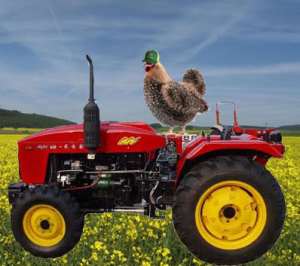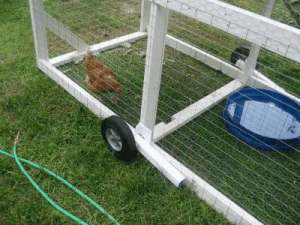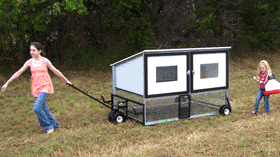 The chicken tractor is an ingenious invention and a classic example of the Permaculture concept of “stacking functions.”
The chicken tractor is an ingenious invention and a classic example of the Permaculture concept of “stacking functions.”
Permaculture is an ecological design philosophy that has been applied to farming. It was popularized by Australia’s own Bill Mollison and David Holmgren. In Permaculture, farmers try to symbiotically co-exist with natural ecologies and mimic the ecologies’ designs to their benefit. When Permaculturists introduce a new plant or animal (generically referred to as an “element”), they try to define the inputs necessary and the outputs expected to gauge how the element will fit into their design. It’s preferable and ingenious to make elements work with one another as much as possible.
Chickens require food, housing, water. They will naturally peck, scratch and hunt when allowed to and they will tear apart or eat most vegetation. They are fine foragers. One output they produce is manure, which is extremely rich in nitrogen. So one way to use this knowledge for maximum benefit is to construct a lightweight, mobile run for some chickens that can be moved about a yard. This is the chicken tractor.
Philosophy
When building a chicken tractor, the foremost consideration should be the comfort and well-being of your chickens. They’re going to be asked to do a lot of work for you! It’s work that chickens love, but it’s work nonetheless. Making sure they have enough space within the tractor and that it is sturdily built to dissuade potential wild predators are things to take into account. Also, you want the chickens in the tractor, so making sure they don’t get out is key. The point of the tractor is to spread out the effect that chickens have. If left free to roam, they will tear apart your garden, peck your vegetables, or kick all your carefully laid mulch all over the place. Look at the tractor as some sort of deal: The chickens want to dig and hunt, so you’re letting them, within reason. Wherever you set them down, grass will get mowed and the earth will be lightly tilled. The chickens will kindly deposit their manure, which rain water and soil microorganisms will break down, diffusing nitrogen throughout the area where the tractor has been. Thanks, chickens!
Design
Let’s look at a simple design, the a-frame chicken tractor. Put simply, it is an elongated, traingular-shaped run with planks extending to the bottom, so that the tractor can be hoisted up and moved. You can make it out of scrap lumber. Check out some a-frames here (http://www.backyardchickens.com/forum/viewtopic.php?pid=2359868). The tractor works best when there’s no floor, so you should have an area you can shut your chickens in when you move them. Otherwise, jailbreak. Have fun chasing them. Detachable wheels might be something to consider if you need to move the tractor over a long distance.
Often included is a roosting and nesting area toward the top of the a-frame. This contributes greatly to the ease and usefulness of the tractor. These will be tighter confines than a traditional coop, so making sure temperature and ventilation (for air quality) are where your chickens like them is important. Making sure the tractor’s coop is clean is also very important. (Chickens poop where they sleep). Having a shaded area where your chickens can get out of the sun or rain is important; chickens do not tolerate hot, direct sun or steady rain for very long and need an area to get out of the elements.
 You should also maintain a constant supply of feed and fresh water. Chickens can get a lot of their dietary needs met through the foraging that they’ll do in the tractor, but hedge your bets. They’re always hungry, anyway.
You should also maintain a constant supply of feed and fresh water. Chickens can get a lot of their dietary needs met through the foraging that they’ll do in the tractor, but hedge your bets. They’re always hungry, anyway.
Use
This is the best part. As a piece of technology, the chicken tractor is nearly “set-in-and-forget-it”. Move the tractor when the area the chickens are on has been modified to whatever degree you’re going for. If you want your yard a little “broken in” and mowed, move the tractor more frequently. If you want to gradually block out and fertilize a new garden bed, let the soil get a bit dry and dusty earth with a lack of grass and buildup of manure and move the tractor within a smaller area. After the chickens move, the area that they were on may look decimated, but in reality, it’s super-fertile and soil moisture won’t be hard to build up with the chickens off of it. It’s also not a bad idea to let your chickens sit on some dusty, dry soil for a little bit, as they root and bathe in dust, which keeps them fr ee of parasites like mites.
ee of parasites like mites.
All you need is a friend to help you move the tractor and a alternating pieces of yard to site the tractor. You can either collect the leavings from the tractor and deposit them in your compost, or wait a bit, then till and plant where the tractor has been. Like I mentioned, chicken manure is very high in nitrogen. At large concentrations, it will “burn” leaves on plants. Diluted, it’s magical stuff.
This has been a brief introduction to the chicken tractor. It’s pretty clever.
Next, we’ll cover raising chicks.
http://www.castleton.co.uk/caverns/